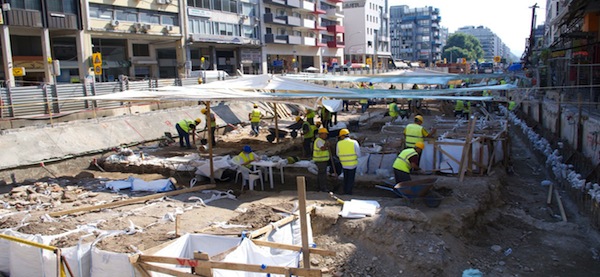
More particularly, the archaeological evidence retrieved from the Demokratia Station concern the suburbs of the ancient city of Thessaloniki, which served mainly as a necropolis until the paleochristian era.The ancient cemetery was built outside the western walls of the city and north of today’s main street Egnatia.The excavated area has unearthed various tombs of different size and pattern, burial offerings, jewellery, lamps, tools, coins and etc.
In the Venizelos Station area archaeologists came across the central road of the Byzantine era city and the nearby ssurroudning neighborhood blocks. Remainings from Stores and workshops have been discovered with an opening to the street for the exhibit of their products, such as jewellery and other pieces of art.
Archaeologists uncovered in the Aghia Sophia Station area a 70 m marble paved road constructed by the Romans some 1,800 years ago. The impressivel well-preserved road will be on public display once the metro works are finished.The Macro area situates the ancient city boundaries. Underneath the Roman road the experts found the remains of a road bulit by the ancient Greeks 500 years ago from that time, which reveals the city’s history over the years. “The ancient road, and side roads perpendicular to it appear to closely follow modern roads in the city today.” explained archaeologist VIki Tzanalouli to Associated Press some months ago.
The Fleming Metro Station revealed a small Roman-era cemetery (ca. 2-4th century BC) probably beloning to an ancient aricultural community residing the area. What is characteristic about this necropolis is the complete lack of burrial offerings and a unique boxlike tomb with grammic engravings amidst the remains.
Excavations in the Metro Depot in Pylaia brought to light the remains of a well-organized pre-Cassadran settling (politisma) which dates back to the early 4th to 3rd century BC. The towns which formed later on Cassander’s great city of Thessaloniki (named after his wife and Alecander the Great’s sister Thessaloniki) are also mentioned by the ancient geographer, Strabo, who lived from 67 BC until 23 AD, in his famous work “Geography”.
See all the latest news from Greece and the world at Greekreporter.com. Contact our newsroom to report an update or send your story, photos and videos. Follow GR on Google News and subscribe here to our daily email!



